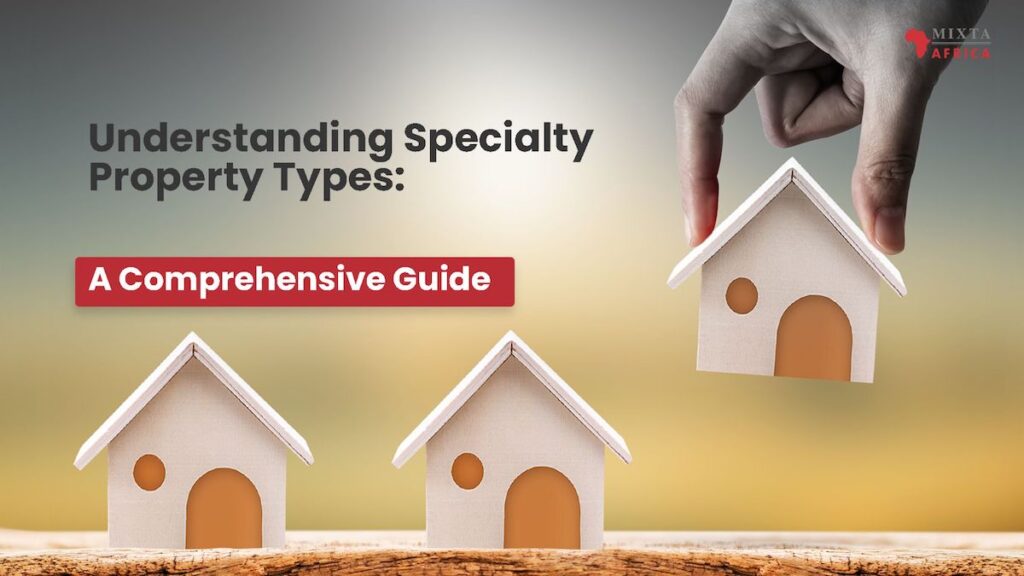In the fascinating world of real estate, there lies a unique segment that often gets overlooked – specialty property types. Understanding this distinctive category of real estate is essential for both seasoned investors and those new to the field, as it offers an intriguing alternative to traditional investments.
So, what are specialty property types? Essentially, these are properties specifically designed or adapted for a unique purpose. Think of your local marina, a charming historic building downtown, or even that awe-inspiring church around the corner – these are all examples of specialty properties, each built with a specific function in mind.
In short, delving into the world of specialty property types can be a game-changer for your investment portfolio. In this article, we will learn all we can about specialty property types.
Historic Properties
Historic properties are a captivating facet of specialty property types. These properties come with their own unique set of characteristics, making them an exciting option for those who appreciate a touch of the past.
Characteristics of Historic Properties
First and foremost, historic properties stand out for their age and the sense of history they evoke. They often feature distinct architectural styles and elements that reflect the period they were built. From Victorian-era houses to Art Deco commercial buildings, each property holds a story within its walls.
Historic properties also often come with certain legal protections. These can include listing on local, state, or national historic registries, which may provide tax benefits but also limit the changes that can be made to the property.
Types of Historic Properties
Historic properties come in many shapes and forms, such as:
- Landmarks: These are properties that have significant historical, architectural, or cultural value. Landmarks often enjoy legal protection against alterations or demolition.
- Historic Districts: These are areas or neighborhoods that have been recognized for their historic significance. Properties within these districts often need to adhere to strict preservation guidelines to maintain the area’s historical character.
- Heritage Sites: These are sites of significant historical, cultural, or natural importance, often recognized and protected at the national or international level.
Pros and Cons of Investing in Historic Properties
Investing in historic properties comes with its unique set of advantages and challenges. On the plus side, these properties can be incredibly appealing due to their unique charm and history. They can attract high-quality tenants and command premium rents, especially if located in desirable areas. Additionally, there can be tax benefits or grants available for restoring and preserving these properties.
On the flip side, owning a historic property often means dealing with stringent regulations regarding renovations and restorations. The cost of upkeep can also be higher due to the age of the property and the need to use specific materials or techniques to maintain its historic integrity. Finally, insuring a historic property can be more expensive due to the potential cost of repairs or restoration following a loss.
Eco-Friendly Properties
In an era where sustainability is of utmost importance, eco-friendly properties offer an enticing option for those seeking to make a positive environmental impact while growing their real estate portfolio.
Characteristics of Eco-Friendly Properties
Eco-friendly properties, also known as green or sustainable properties, are designed with environmental conservation in mind. They integrate materials and technologies that minimize environmental impact and create healthier living spaces. Key characteristics can include energy-efficient appliances, sustainable building materials, water conservation systems, and even solar panels or green roofs.
Types of Eco-Friendly Properties
There are a few different types of eco-friendly properties, such as:
- Green Buildings: These properties are designed and operated to reduce or eliminate their negative impact on the environment. They might employ sustainable materials in construction, energy-efficient lighting and appliances, and innovative heating and cooling systems.
- Sustainable Homes: These are residential properties built with environmentally friendly materials and designed to minimize the home’s carbon footprint. They often feature energy-efficient appliances, solar panels, and water conservation systems.
- LEED Certified Buildings: Leadership in Energy and Environmental Design (LEED) is a globally recognized certification for green buildings. Buildings achieving LEED certification have met stringent standards for energy efficiency, water usage, air quality, and more.
Pros and Cons of Investing in Eco-Friendly Properties
As with any investment, there are both advantages and challenges when it comes to investing in eco-friendly properties. On the bright side, these properties are often in high demand due to growing environmental awareness and the desire for healthier living spaces. They can command higher rents or sale prices and may qualify for tax benefits or incentives related to sustainable building practices.
However, the initial costs of eco-friendly properties can be higher due to the price of sustainable materials and technologies. In addition, as a property owner, you might need to deal with the complexity of green building certifications and stay abreast of ever-evolving sustainability standards and technologies.
Mixed-Use Properties
Mixed-use properties are a captivating breed of specialty property types that seamlessly blend residential and commercial spaces. They offer a vibrant and integrated environment, providing a range of benefits for both investors and the community.
Characteristics of Mixed-Use Properties
One of the key characteristics of mixed-use properties is their versatile nature. These properties combine different types of uses within a single development, allowing for a harmonious coexistence of residential, commercial, and sometimes even industrial components. They can feature a mix of apartments, condos, offices, retail spaces, restaurants, and entertainment venues, all within the same building or complex.
Types of Mixed-Use Properties
Mixed-use properties come in various forms, catering to different needs and preferences:
- Residential and Commercial Spaces: These properties combine residential units, such as apartments or condos, with commercial spaces on the ground floor or within the same complex. This allows residents to have convenient access to amenities like shops, restaurants, or offices, fostering a sense of community.
- Retail and Office Spaces: In this type of mixed-use property, the focus is on integrating retail and office spaces. It can include ground-level retail units with office spaces above or adjacent, creating a vibrant atmosphere with a balance between work and leisure.
- Live-Work Spaces: Live-work mixed-use properties are designed specifically for individuals who wish to combine their living and workspaces. These properties provide separate areas for both residential living and business operations, enabling entrepreneurs to run their businesses conveniently from home.
Pros and Cons of Investing in Mixed-Use Properties
Investing in mixed-use properties offers a range of potential advantages. One significant benefit is the diversification of income streams. The combination of residential and commercial spaces can lead to a more stable and predictable cash flow. Additionally, mixed-use properties often enjoy high demand, as they cater to people’s desire for convenience and a live-work-play lifestyle.
However, there are some considerations to keep in mind. Mixed-use properties can be more complex to manage, as they involve multiple types of tenants and require careful coordination. Zoning and permitting regulations can also be more intricate compared to single-use properties. It’s essential to conduct thorough market research and due diligence to ensure the property’s location and mix of uses align with the local market demand.
Resort Properties
Resort properties are a captivating subset of specialty property types, known for their ability to whisk vacationers away to idyllic destinations where relaxation and adventure meet. Understanding the characteristics of resort properties is essential for those looking to invest in the hospitality industry or seeking their own slice of paradise.
Characteristics of Resort Properties
One of the defining characteristics of resort properties is their focus on creating memorable experiences for guests. These properties are designed to provide a wide range of amenities and services, catering to the desires and preferences of vacationers. Resort properties often feature luxurious accommodations, world-class dining options, recreational facilities, spa and wellness centers, and breathtaking natural surroundings.
Types of Resort Properties
Resort properties can take various forms, each catering to different vacation experiences and destinations:
- Beachfront Resorts: These properties are situated along picturesque coastlines, offering pristine beaches and stunning ocean views. They typically provide a host of water-based activities, such as snorkeling, swimming, and water sports, as well as beachfront dining options.
- Ski Resorts: Located in mountainous regions with snowy slopes, ski resorts are a haven for winter sports enthusiasts. These properties offer ski-in/ski-out accommodations, ski rentals, ski schools, and après-ski activities like cozy fireside lounges and hot tubs.
- Golf Resorts: Golf resorts are a golfer’s paradise, boasting meticulously designed courses and top-notch facilities. They often feature upscale accommodations, golf academies, and other recreational amenities such as spas and fine dining options.
- All-Inclusive Resorts: All-inclusive resorts provide guests with a comprehensive vacation experience, where accommodations, meals, drinks, and activities are bundled into one package. These properties aim to create a hassle-free and indulgent escape for guests.
Pros and Cons of Investing in Resort Properties
Investing in resort properties offers both enticing advantages and unique challenges. One significant advantage is the potential for attractive returns, as resort properties often generate revenue from accommodations, dining, and additional services. They can be particularly lucrative in popular tourist destinations with consistent demand.
However, it’s crucial to be aware of the challenges associated with resort properties. These properties require a significant upfront investment, not only for the initial purchase but also for ongoing maintenance, upgrades, and staffing. They are also heavily dependent on tourism trends and can be susceptible to economic downturns or shifts in traveler preferences. Proper market analysis and understanding the target audience are crucial for successful investment in resort properties.
Medical Properties
Medical properties are a unique subset of specialty property types that cater to the needs of the healthcare industry. These properties provide essential spaces for medical services, contributing to the well-being of individuals and communities. Understanding the characteristics of medical properties is key to exploring their potential as an investment avenue.
Characteristics of Medical Properties
One of the defining characteristics of medical properties is their specialized infrastructure designed to support healthcare operations. These properties often feature specific layout considerations to accommodate medical equipment, treatment rooms, waiting areas, and administrative spaces. They may require compliance with regulatory standards and zoning requirements to ensure patient safety and privacy.
Types of Medical Properties
Medical properties encompass various types, each serving different functions within the healthcare ecosystem:
- Hospitals: Hospitals are large-scale medical facilities that provide a wide range of medical services, including emergency care, surgeries, specialized treatments, and inpatient care. They require significant resources and expertise to operate effectively.
- Clinics and Medical Offices: These properties offer outpatient medical services and specialized care, such as general practitioner clinics, specialty clinics (e.g., dermatology, orthopedics), and private medical offices. They are typically smaller in scale and can be owned or leased by healthcare professionals.
- Medical Office Buildings (MOBs): MOBs are purpose-built structures or complexes that house multiple medical practices, often in close proximity to hospitals or other healthcare facilities. They provide convenient access to a variety of healthcare services and foster collaboration among healthcare professionals.
Pros and Cons of Investing in Medical Properties
Investing in medical properties can present several advantages for investors seeking long-term stability and potential financial rewards. Here are a few key pros:
- Stability and Demand: The demand for healthcare services remains relatively stable regardless of economic fluctuations, providing a reliable tenant base for medical properties.
- Potential for Growth: The healthcare industry continues to evolve and expand, presenting opportunities for growth in medical property investments.
- Longer Lease Terms: Medical tenants often prefer longer lease terms, providing stability and potential income security for property owners.
However, investing in medical properties also comes with certain considerations:
- Specialized Knowledge: Understanding healthcare regulations, compliance, and market dynamics is essential to effectively manage medical properties.
- Tenant Turnover: While longer lease terms are a benefit, tenant turnover in the medical field can still occur, requiring proactive management and tenant replacement.
- Higher Initial Costs: Medical properties often require specialized infrastructure, such as medical-grade facilities and equipment, which can involve higher initial investment costs.
Educational Properties
Educational properties are a unique subset of specialty property types that cater to the needs of the education sector. These properties serve as spaces where knowledge is imparted, minds are nurtured, and the next generation is prepared for the future. Understanding the characteristics of educational properties is key to exploring their potential as an investment avenue.
Characteristics of Educational Properties
One of the defining characteristics of educational properties is their specialized infrastructure designed to support teaching and learning activities. These properties often feature classrooms, laboratories, libraries, administrative areas, and recreational spaces. They are built to meet the specific needs of educational institutions and foster an environment conducive to effective education.
Types of Educational Properties
Educational properties encompass various types, each serving different educational purposes:
- Schools: Schools include primary schools, secondary schools, and K-12 institutions. These properties focus on providing education to children and teenagers. They may consist of classrooms, sports facilities, playgrounds, and administrative areas.
- Universities and Colleges: Universities and colleges are institutions of higher education. These properties typically have multiple faculties, departments, research facilities, libraries, student centers, and residential buildings. They cater to undergraduate and postgraduate students pursuing advanced degrees.
- Student Housing: Student housing properties provide accommodation for students attending educational institutions away from home. These properties can range from dormitories to purpose-built apartment complexes. They often feature amenities and services tailored to the needs of students.
Pros and Cons of Investing in Educational Properties
Investing in educational properties can offer several advantages for investors seeking stable returns and long-term benefits. Here are a few key pros:
- Stability and Demand: The demand for education is a fundamental and recurring need, providing a steady tenant base for educational properties.
- Long-Term Leases: Educational institutions often prefer longer lease terms, providing stability and potential income security for property owners.
- Social Impact: Investing in educational properties allows you to contribute to the development and growth of future generations by providing them with quality learning environments.
However, investing in educational properties also comes with certain considerations:
- Seasonal Vacancies: Depending on the educational calendar, some properties, such as student housing, may experience vacancies during breaks or summer months.
- Maintenance and Renovation: Educational properties may require regular maintenance and occasional renovation to meet evolving educational standards and accommodate changing enrollment numbers.
- Regulatory Considerations: Compliance with local regulations and educational standards is crucial for educational properties, requiring ongoing attention and adherence.
Government Properties
Government properties form a distinctive subset of specialty property types that cater to the operational needs of local, state, or federal government entities. These properties play a critical role in the functioning of governments and can offer interesting avenues for investment. Understanding the characteristics of government properties is key to exploring their potential as an investment opportunity.
Characteristics of Government Properties
One of the defining characteristics of government properties is their affiliation with public institutions and their specialized purpose. These properties are designed to accommodate the administrative, legal, and operational functions of government entities. They often possess a sense of grandeur, reflecting the importance and authority associated with government institutions.
Types of Government Properties
- Courthouses: Courthouses are facilities where judicial proceedings take place. They typically include courtrooms, judge’s chambers, offices for court personnel, and related support services. Courthouses are crucial for the administration of justice and maintaining the rule of law.
- Post Offices: Post office buildings serve as central hubs for postal services within a community or region. They house mail sorting facilities, postal counters, and administrative offices. Post offices play a vital role in mail distribution and communication.
- Government Office Buildings: Government office buildings are spaces where government agencies and departments operate. These properties accommodate administrative offices, meeting rooms, and public service areas. They serve as hubs for public services and government operations.
- Military Bases: Military bases are installations used by armed forces for training, housing, and operational purposes. They can include barracks, training facilities, administrative offices, and other infrastructure essential for military operations.
Pros and Cons of Investing in Government Properties
Here are a few key pros of investing in government properties:
- Stability and Reliability: Government entities are typically stable tenants with long-term lease commitments, providing a predictable income stream.
- Creditworthiness: Government tenants often have high credit ratings and reliable payment histories, reducing the risk of tenant default.
- Maintenance Responsibility: Government tenants often assume responsibility for property maintenance and repairs, alleviating the burden on property owners.
There are also some pros when investing in government properties:
- Government Budget Constraints: Government budgets can be subject to constraints or changes that may affect future lease negotiations or property usage.
- Limited Market Availability: They may have limited availability in certain areas, making it challenging to find suitable investment opportunities.
- Specialized Knowledge: Understanding government leasing processes and regulations is important for successful investment in government properties.
Factors to Consider When Choosing a Specialty Property Type
1. Market Demand
Assessing market demand is essential to determine the viability of a specialty property investment. Research the current and projected demand for the specific property type in the target location. Consider factors such as population growth, economic indicators, and market trends. Understanding the demand dynamics will help ensure a consistent and reliable tenant or buyer base for the property.
2. Location
The location of the specialty property is of paramount importance. Consider proximity to amenities, transportation networks, and target demographics. Evaluate the neighborhood’s desirability and potential for growth. A prime location can positively impact property value, rental rates, and demand.
3. Regulations and Zoning Laws
Familiarize yourself with the regulations and zoning laws that govern the specific property type in the chosen location. Ensure compliance with building codes, safety requirements, and any other applicable regulations. Understanding the legal framework will help mitigate potential risks and ensure a smooth investment process.
4. Accessibility
Consider the accessibility of the specialty property to potential tenants, customers, or visitors. Evaluate transportation infrastructure, parking availability, and proximity to major roads or public transit. Easy accessibility enhances the property’s attractiveness and can positively influence its long-term success.
5. Potential for Growth and Appreciation
Assess the potential for future growth and appreciation of the specialty property. Look for indicators such as planned infrastructure developments, economic expansion, or emerging trends in the industry. Investing in a property with growth potential can lead to increased value and higher returns over time.
Financing Options for Specialty Properties
1. Traditional Mortgages
Traditional mortgages are a common financing option for specialty properties. They involve borrowing funds from a financial institution, typically a bank, to purchase the property. Traditional mortgages offer competitive interest rates and repayment terms based on the borrower’s creditworthiness and the property’s value. It’s important to note that lenders may have specific criteria or restrictions for specialty property types.
2. Specialized Loans and Grants
Specialized loans and grants are tailored financing options designed specifically for certain types of specialty properties. These options may be available for properties with specific purposes, such as historic preservation, eco-friendly features, or community development. They often come with favorable terms, reduced interest rates, or extended repayment schedules. These loans and grants can be obtained through government programs, non-profit organizations, or specialized financial institutions.
3. Tax Credits and Incentives
Tax credits and incentives can provide financial benefits to investors in specialty properties. Governments at the local, state, or federal level may offer tax credits or deductions for investing in certain types of properties, such as historic buildings or eco-friendly developments. These incentives can help offset costs and improve the financial viability of the investment. It’s important to consult with tax professionals or experts to understand the specific credits and incentives available in your jurisdiction.
4. Public-Private Partnerships
Public-private partnerships (PPPs) involve collaboration between government entities and private investors to finance and develop specialty properties. In these partnerships, the public sector may provide funding or land while the private sector contributes expertise, capital, and management. PPPs are commonly used for large-scale projects such as infrastructure development, hospitals, or educational facilities. They can offer unique financing arrangements and long-term revenue-sharing opportunities.
Tips for Buying and Selling Specialty Properties
1. Conduct Market Research and Due Diligence
Before buying or selling a specialty property, conduct thorough market research and due diligence. Understand the current market conditions, demand for the specific property type, and pricing trends. Analyze comparable sales or rental rates to determine fair value. For buyers, evaluate the property’s condition, potential risks, and future growth prospects. For sellers, highlight the unique features and advantages of the property to attract potential buyers.
2. Navigate Regulations and Legal Considerations
Specialty properties often have unique regulations and legal considerations. Familiarize yourself with zoning laws, building codes, environmental regulations, and any other specific requirements for the property type. Ensure compliance with all necessary permits and licenses. Engage professionals, such as lawyers or consultants, who specialize in the relevant regulations to guide you through the process.
3. Negotiate the Price and Terms of the Sale
Effective negotiation skills are crucial when buying or selling specialty properties. Buyers, strive to negotiate a fair purchase price based on market research and property assessments. Consider additional terms, such as financing options or contingencies, that may impact the overall transaction. For sellers, be prepared to justify the asking price and highlight the value of the property. Consider potential offers and negotiate terms that align with your objectives.
4. Market the Property Effectively
Proper marketing is essential for attracting potential buyers or tenants. Utilize various channels, such as online listings, professional networks, and targeted advertising, to reach the appropriate audience. Highlight the unique features, benefits, and potential returns of the specialty property. Leverage high-quality visuals, virtual tours, and detailed property descriptions to showcase its value. Engage the services of a real estate agent or marketing professionals, if necessary, to maximize exposure.
Conclusion
Staying up-to-date with industry trends is crucial in specialty property investments. Seek professional advice to navigate the nuances of each property type effectively. Stay curious and continuously learn to maximize your investment potential. Good luck on your specialty property journey!











